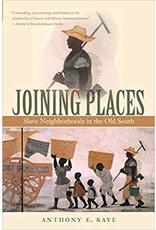A detailed portrait of slave men and women venturing beyond the limits of their master's domain to adjoining plantations. . . . An important contribution to the scholarship on slavery. Given the merits of Kaye's antebellum study, one hopes that historians of other periods will examine the importance of place to African Americans.--Journal of Mississippi History
Kaye joins a growing body of work that explores the complicated, contested nature of community, power, and labor, leading the scholarship toward a denser awareness of life within slavery.--Enterprise and Society
An original and persuasive interpretation of slavery and slave life. . . . Boldly conceived and fluently written. . . . An important book, one that will surely become a staple in graduate courses on southern and African American history. . . . Kaye has shifted the scholarly conversation.--American Historical Review
Add[s] impressively to the list of scholars who have forced a rethinking about slavery in the Old South. . . . Kaye has resurrected a cache of primary documents that are crucial to any full understanding of how slaves persevered. For this, and for producing a first-rate study, Kaye is to be commended.--The Historian
Make[s] an impressive addition to recent scholarship and should be essential reading for those interested in the history and historiography of the antebellum South.--Georgia Historical Quarterly
A finely detailed and richly documented narrative. . . . This volume can be expected to have wide-ranging influence on the future study of the lives of the enslaved and the plantation economy that held them in bondage.--Journal of the Early Republic
Based on path-breaking research that accomplishes something unthinkable at this late date: it excavates a too-rarely used, massive set of sources that reports new words from ex-slaves speaking about their experiences before emancipation. . . . A rewarding, even exciting contribution to the scholarship of slavery and African-American history. . . . A detailed, breathing portrait of slavery in the Natchez District, one that sometimes is shocking in its living tints. . . . All who study slavery in North America need to read this important new work.--Journal of Interdisciplinary History
Joining Places offers a new approach to familiar questions about the character of slave society and community. . . . [It] demonstrates how 'neighborhood' shaped slaves' work and socialization, their creation of marriage and family ties, and the resistance they offered to slaveholders and the slave regime.--Frederick Douglass Book Prize Committee
By reconceptualizing slaves as living within complex, shifting, historically and spatially specific 'neighborhoods,' Joining Places suggests a promising way out of the increasingly unproductive historiographical impasse between slaves' agency and masters' power. . . . Throughout, Kaye's painstaking examination of his subjects' language leads to new insights.--Journal of American History
Recapture[s] both the fluidity and yearning for stability that marked the lives of the enslaved in this dynamic locale.--The North Carolina Historical Review
This is a boldly conceptual and deeply empirical book that refigures and advances some of the most important historiographical debates of the past thirty years in scholarship on slavery in the United States. It is ambitious, smart, and compelling.--Walter Johnson, Harvard University, author of Soul by Soul: Inside the Antebellum Slave Market
From the Inside Flap
In this new interpretation of antebellum slavery, Kaye offers a vivid portrait of slaves transforming adjoining plantations into slave neighborhoods. He describes men and women opening paths from their owners' plantations to adjacent farms to go courting and take spouses, to work, to run away, and to otherwise contend with owners and their agents. Demonstrating that neighborhoods prevailed across the South, Kaye reformulates ideas about slave marriage, resistance, independent production, paternalism, autonomy, and the slave community that have defined decades of scholarship. This is the first book about slavery to use the pension files of former soldiers in the Union army, a vast source of rich testimony by ex-slaves.
From the Back Cover
In this new interpretation of antebellum slavery, Kaye offers a vivid portrait of slaves transforming adjoining plantations into slave neighborhoods. He describes men and women opening paths from their owners' plantations to adjacent farms to go courting and take spouses, to work, to run away, and to otherwise contend with owners and their agents. Demonstrating that neighborhoods prevailed across the South, Kaye reformulates ideas about slave marriage, resistance, independent production, paternalism, autonomy, and the slave community that have defined decades of scholarship. This is the first book about slavery to use the pension files of former soldiers in the Union army, a vast source of rich testimony by ex-slaves.
About the Author
Anthony E. Kaye (1962-2017) was associate professor of American history at Pennsylvania State University.


